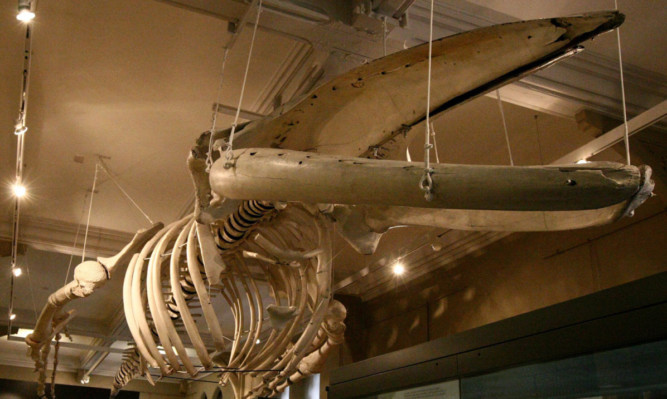It was described as an “incredible chase” which exercised the imagination of a country and was immortalised by Scotland’s most infamous poet.
The 16.5-tonne, 40-foot long “great Tay whale” was harpooned by Dundee sailors and chased to its end 45 miles up the Mearns coast in 1883.
Its skeleton, a prize among Victorian scholars so valuable that two men stopped at nothing to obtain and study it, now has pride of place at the McManus in Dundee.
And two artists have joined forces to commemorate the chase and capture, with an exhibition starting today.
Unknown to each other, artist Stuart Buchanan and songwriter Dave Ramsay had been working on their own tribute to the whale in the small village of Catterline.
It was only when Stuart produced a painting that Dave disclosed he had written his own song.
The tale began when a humpback whale entered the Tay estuary and spurred a chase that stretched along the coastline from Dundee to Stonehaven.
Dundee whalers harpooned the humpback in the estuary on December 31, but the male towed two rowing boats and two steamboats as far as Montrose.
The harpoon lines broke and the whale escaped north, but was next seen stricken off Bervie Brow by Alex Ritchie, skipper of the Gourdon fishing boat The Olive Branch.
Two other boats helped get a line across the tail and towed the animal to Stonehaven.
It was auctioned and bought by showman John Woods of Dundee for £226 and was towed back to Dundee to be stripped of the blubber and for public exhibition.
Aberdeen anatomist John Struthers dissected the whale in public from January 25 1884, with Woods organising a military band to play in the background.
Woods had the carcass stuffed and took the whale on a tour around Britain, making a lot of money, and Struthers became eminent among the whale biologists of his time.
Mr Buchanan said he had been “fascinated” by the story since visiting the McManus, which has been the whale’s home since it was moved from the Barrack Street museum in 1983.
He added: “I am interested in many aspects of the old whaling industry, especially the strong connections with the towns and ports in this area and have incorporated these subjects into paintings.”
Mr Ramsay said: “After a chance cliff-top conversation with Stuart, I decided there was a chance to bring this story to life for the Maggie Law Museum in Gourdon, given the strong local connections, and also to feature Stuart’s work, as he has other pieces of his art on display in the museum at present.”
William McGonagall’s poem The Famous Tay Whale includes references to Gourdon, Stonehaven and many other place names in the Mearns.
Mr Buchanan’s finished painting, which is under wraps until 1pm today, will go on show alongside a host of materials telling the tragic animal’s story.
The exhibition runs at the Maggie Law Museum in Gourdon until Sunday.
